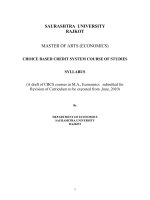Immune mechanisms of responses to environmental mycobacteria
Bạn đang xem bản rút gọn của tài liệu. Xem và tải ngay bản đầy đủ của tài liệu tại đây (2.5 MB, 196 trang )
IMMUNEMECHANISMSOFRESPONSESTO
ENVIRONMENTALMYCOBACTERIA
HOPEIYING
(M.Sc,NUS)
ATHESISSUBMITTED
FORTHEDEGREEOFDOCTORATEOFPHILOSOPHY
DEPARTMENTOFMICROBIOLOGY
NATIONALUNIVERSITYOFSINGAPORE
2011
i
ACKNOWLEDGEMENTS
Funding for this research was received from grants funded by the Ministry of
EducationandMicrobiologyDepartmentVaccine Initiativeawardedto DrSeah
Geok Teng (2006 – 08), and from the National Research Foundation (2008 –
2011)undertheauspicesoftheSingapore‐MITAllianceforResearch and
Technology (SMART) Infectious Disease Interdisciplinary Research Group (ID‐
IRG)whereDrSeahGeokTengandthelateProfessorDavidBSchauer were
investigators.Mygraduatestudieswerefinancedbyascholarshipfundedbythe
MinistryofEducationthroughtheYongLooLinSchoolofMedicine Graduate
Programme,andpartiallybySMART.
Thishasbeenatoughandarduousjourney,andeverythinginthisthesiswould
nothavebeenpossibleifnotforthemany people whohaveso selflesslygiven
mesoundguidance,strongsupportandimmenseencouragementalongtheway.
Iowemydeepestgratitudetomysupervisorandmentor,DrSeahGeokTeng,for
herinvaluable guidanceand advice,her strongsupportin timesofuncertainty
andwhenIwasfarawayinaforeignland,andespeciallyfordevoting her
precioustimetomyprojectamidsthermultiplerolesasanadjunctprofessor,a
practicingdoctorandanewmother,inthelastlegofmyPhD.Ialsoextendmy
sincerethankstomylateco‐supervisor,ProfessorSchauer,forthefine
experienceatMIT,forgivingmemuchaidandadviceduringmystintinhislab
(Sept08‐Jul09),aswellassincereconcernovermywell‐being.Youwillalways
bedeeplyremembered.ItiswithpleasureandheartfeltgratitudethatIgivemy
ii
specialthankstomycolleagues,MrsThong,Wendy,ChaiLian,Irene,Nicola,Tse
Mien, Megan, Puk, Adrienne, Katie and Alex, who have given me much needed
support,especiallyonbadexperimentaldays,andkeptmesaneatonepointor
anotherthroughthecourseofmyPhD.MyspecialthanksalsotoMrYNChan,
MrsKTThong,ArekandSiewChinfortheirtechnicalhelpwithmanaging the
equipmentneeded for thisproject,including the flowcytometersand Luminex
machine.IfeelindebtedtomymanycolleaguesintheSGTlabat NUS, in the
SchauerlabatMIT,aswellasinSMART,particularlyCarmen,Joanne,WeiXing,
Arek,Isadora,SiewChin,HooiLinn,Maggie,DaHai,Lena,YieHou,LanHiong,
RashidiandFarzadforkindlygivingmemuchassistanceandhelp in multiple
waysalongtheway.Last,butnottheleast,Igivemywholeheartedthankstomy
entirefamilyfortheirstrong,unwaveringsupportandunderstandingduringmy
PhDpursuit,especiallytotheloveofmylife–myhusbandAaron,withoutwhom
Iwouldnothavemadeitsofar.
iii
SUMMARY
Human epidemiological studies suggest that poor efficacy of the tuberculosis
(TB) vaccine, Mycobacterium bovis bacilleCalmette‐Guérin(BCG),maybe
because of immuno‐modulatory effects of exposure to environmental
mycobacteria (Env). However, exactlyhowandwhythishappensremains
unclear.ThisstudyexaminedthehypothesisthateffectsofEnvsensitisationare
relatedtoinductionofregulatoryandcytotoxicTcells.Mycobacteriumchelonae
(CHE)sensitisationofBalb/cmicethroughvariousrouteswasusedasthemodel
system.
Heat‐killedCHE intra‐peritonealsensitisationinducedCD4
+
Tcellswhichlysed
BCG‐infected macrophages in vitro. The cytotoxicity was dependent on IFN‐,
perforinandFasL.Sensitisationwithanunrelatedbacteriumfailed to induce
cytotoxicity,thereforepriming ofT cellscross‐reactive withBCG, andnot non‐
specific inflammation, underlies the cytotoxicity. Sensitised mice had reduced
BCGviabilityinthelungsuponsubsequentinhalationchallenge;thiscanexplain
thereducedBCG‐inducedprotection.
BothIFN‐γandIL‐10wereincreasedinthelungsofCHE‐sensitisedmice,relative
tonaïvemice,afterBCGlungchallenge.Althoughthefrequencyofsystemic
CD4
+
CD25
+
cellswasunremarkableafterCHEsensitisation,adoptivetransferof
these Tregs to naïve mice followed by BCG challenge led to reduced lung
lymphocyte recruitment, reduced lung IL‐2 and increased systemic IL‐10
iv
production. This suggests functional suppression of local BCG responses by
CD4
+
CD25
+
TregsfromCHE‐sensitisedmice.
Memory responses after transient CHE lung colonisation led to increases in
TregsweeksafternoliveCHEwasrecoverable.Differentdosesof inhaledCHE
exposure were tested – higher doses induced stronger Treg responses and
weaker BCG‐specific IFN‐γ responses. Subsequent experiments used repeated
lowdoseliveintra‐trachealCHEexposuretomimicnaturalhumaninhalational
exposure, followed by subcutaneous BCG vaccination. Systemic IL‐10, mainly
produced by CD4
+
CD25
‐
FoxP3
+
inducible Tregs, was increased and associated
withreducedfrequencyofIFN‐γproducingmemorycellsrecognising a BCG‐
specific epitope. Thus, adaptive Tregs also have a role in suppressing BCG‐
specificinflammationinCHE‐sensitisedmice.
To explore if post‐BCG CHE exposure had similar effects, BCG vaccination of
weanling mice was followed by low dose CHE intra‐tracheal exposures. This
mainlyinducednaturalTregs,withminimalIL‐10induction.Suppression of
inflammatory cell recruitment in the lungs to subsequent BCG lung challenge
was noted, associated with reduced lung chemokines, in spite ofelevated
systemicIFN‐γresponses.Therateofinflammatorycellrecruitmenttothelung
early in TB infection is increasingly recognised as the critical determinant of
effective immunity, more than systemic IFN‐γ responses. Thus, CHE exposure
evenafterBCGvaccinationcansuppressMycobacterium‐specificimmunity.
v
These two mechanisms proposed for effects of CHE exposure on BCG‐induced
immunityarenovel.Thisworkisalsothefirsttoprovideamechanistic
explanationforhowEnvexposuremodulatesanexistingBCGvaccineresponse.
This accounts for observations of lack of BCG‐induced protection in humans
livinginEnv‐prevalentareas,andsuggestshowprospectivecandidate TB
vaccines could be screened to avoid problems of BCG vaccine. It also explains
why even early neonatal BCG vaccination fails to provide long‐lasting effects
againstadultpulmonaryTB,withimplicationsforitscontinueduse.
Publicationsarisingfromthisthesis
Journalpapers:
1) Peiying,Ho,LinZhang,XingWeiandGeokTengSeah(2009).
MycobacteriumchelonaesensitisationinducesCD4
+
‐mediatedcytotoxicity
againstBCG.EurJImmunol39(7):1841‐9
2) Peiying, Ho, Xing Wei and Geok Teng Seah (2010). Regulatory T cells
induced by Mycobacterium chelonae sensitization influence murine
responsestobacilleCalmette‐Guérin.JLeukocBiol88:1073‐80.
ThisarticlewasfeaturedintheFrontlineScienceSectionofJLBas"Leading
EdgeResearch"withadedicatededitorialandpressrelease
Conferencepresentations:
1) Peiying,Ho,MeganMcBee,GeokTengSeahandDavidSchauer.M.
chelonae exposure post‐BCG vaccination suppresses BCG‐specific
responses. Poster presentation. International Congress of Mucosal
Immunology,July2009,Boston,USA.
vi
2) Effects of environmental mycobacteria post‐BCG vaccination. Oral
Presentation. Singapore MIT Alliance for Research and Technology
(SMART)Infectious Diseases Inter‐disciplinary Research Group (ID‐IRG)
Workshop,January2010,Singapore.Wonbestoralpresentationaward.
3) Peiying,Ho,Carmen,Low,Joanne,Kang,TseMienTan,NicolaLeungand
Geok Teng Seah. Mycobacterium chelonae sensitisation prior to BCG
vaccination induces regulatory T cells that suppress IFN‐ responses.
Poster presentation. SMART ID‐IRG Annual Workshop July 2010,
Singapore.
vii
TABLEOFCONTENTS
ACKNOWLEDGEMENTS i
SUMMARY iii
LISTOFFIGURES xvi
ABBREVIATIONS xviii
CHAPTER1–INTRODUCTION 1
1.1Theglobaltuberculosissituation 1
1.2Immuneresponsesofenvironmentalmycobacteriaexposureandeffects
onBCGvaccination 2
1.3Objectivesandscopeofproject 3
CHAPTER2–LITERATUREREVIEW 5
2.1Epidemiologyoftuberculosis(TB) 5
2.1.1Clinicaltuberculosis 5
2.1.2Bacterium‐hostimmuneinteractions 6
2.2ImmuneresponsestoTB:celltypesandtheirfunctions 7
2.2.1CD4cells 7
2.2.2CD8cells 9
2.2.3Tcells 10
2.2.4Naturalkiller(NK)cells 11
2.2.5Othercells 11
2.2.5.1CD1‐restrictedTcells 11
2.2.5.2Bcells
12
2.2.5.3Antigenpresentingcells 12
viii
2.3Relevancetovaccinedevelopment 13
2.4BCGasavaccine 13
2.4.1MeasuringBCGresponses 14
2.4.2BCGprotectiveefficacy 16
2.4.2.1Humantrials 16
2.4.2.2Experimentalmodels 17
2.4.3RoutesofBCGadministration 18
2.5Cell‐mediatedimmuneresponseswithBCGvaccinationandimmune
correlatesofprotection 19
2.5.1Thelpertype1CD4
+
responseandIFN‐responses 19
2.5.2CD8
+
Tcells 20
2.5.3RegulatoryTcell(Treg)responses 21
2.6ProblemswithBCGandnovelstrategiestoreplaceorimproveBCGasaTB
vaccine 22
2.7Environmentalmycobacteria(Env) 25
2.7.1ClassificationofEnv 26
2.7.2M.chelonae(CHE) 27
2.8ImmuneresponsestoEnv 27
2.9EffectsofenvironmentalmycobacteriaexposureonBCGvaccination 29
2.10RegulatoryTcells(Tregs) 32
2.10.1NaturalTregs(nTregs) 33
2.10.2NaturalTregsinTB 35
2.10.3AdaptiveorinducibleTregs(iTregs) 36
2.10.4IL‐10inTBdisease 37
ix
CHAPTER3–MycobacteriumchelonaesensitisationinducesCD4
+
‐mediated
cytotoxicityagainstBCG 38
3.1INTRODUCTION 38
3.2MATERIALSANDMETHODS 40
3.2.1Mice… 40
3.2.2Bacteria 40
3.2.3Preparationofheat‐killedandlivebacterialcultures 40
3.2.4MurineimmunisationandliveBCGchallenge 41
3.2.5Isolationofmurineperitonealmacrophages 42
3.2.6Isolationofmurinesplenocytesandlungtissue 42
3.2.7TrypanBlueexclusionassay 43
3.2.8Positivecellselectionusingmagneticbeads 43
3.2.9CytokineanalysisbyELISA 44
3.2.10Cytotoxicityassay 45
3.2.11Cytotoxicityassayexperimentalset‐up 45
3.2.12Flowcytometry 47
3.2.13Statisticalanalysis 47
3.3RESULTS 49
3.3.1Cellsubsetsinvolvedincytotoxicity 49
3.3.2Mediatorsofcytotoxicity 53
3.3.3Specificityofcytotoxicresponses 53
3.3.4EffectofEnvsensitisationonliveBCGinfection 56
3.4DISCUSSION 59
3.4.1CD4
+
TcellsinvolvedinCHE‐mediatedcytotoxicity 59
3.4.2CHE‐inducedcytotoxicitydependentonFasLandperforin 60
x
3.4.3CHE‐inducedcytotoxicityassociatedwithmycobactericidal
activity 61
3.4.4IFN‐dependentCHE‐mediatedcytotoxicity 62
3.4.5PotentialreasonsfordifferentialresponsestoEnvsensitisation 63
3.4.6Conclusion 65
CHAPTER4–EvidenceforregulatoryTcellactivityinMycobacterium
chelonaesensitisedmiceandfunctionalimpactofCD4
+
CD25
+
cellsonBCG
responses 66
4.1INTRODUCTION 66
4.2MATERIALSANDMETHODS 68
4.2.1Mice&Immunisation 68
4.2.2Bronchoalveolarlavage(BAL) 68
4.2.3Cellsortingandadoptivetransfer 68
4.2.4Co‐cultureproliferationsuppressionassay 69
4.2.5ELISA 70
4.2.6Flowcytometry 70
4.2.7Statistics 71
4.3RESULTS 72
4.3.1CHEsensitisationreducesIFN‐γandincreasesIL‐10production
withassociatedreducedlymphocyteactivity 72
4.3.2Reducedlunginflammatorycellsandincreasedlungcytokinesupon
BCGlunginfectionafterCHEsensitisation 73
4.3.3UnremarkablefrequencyofCD4
+
CD25
+
cellswithCHE
sensitisation 77
xi
4.3.4CD4
+
CD25
+
cellsfromsensitisedmicereduceIFN‐γproductionand
proliferationofco‐culturedeffectorcells 78
4.3.5AdoptivetransferofCD4
+
CD25
+
TregsfromCHE‐sensitisedmice
suppressesBCGresponses 82
4.4DISCUSSION 85
4.4.1NaturalandinducedTregswithCHEsensitisation 85
4.4.2UsageofdeadCHEforsensitisation 85
4.4.3QualitativesuppressiveactivityofCD4
+
CD25
+
Tregswithout
quantitativechanges 86
4.4.4Tregsmayaffectnon‐Tcelltypes 88
4.4.5PotentialmechanismsforCHE‐inducedTregactivity 88
4.4.6Conclusion 89
CHAPTER5–DifferentialeffectsofvaryingMycobacteriumchelonae
exposureparametersandeffectsofincreasedIL‐10producingregulatoryT
cellswithlowdoseinhaledexposure 91
5.1INTRODUCTION 91
5.2MATERIALSANDMETHODS 93
5.2.1Bacteriastrains,miceandimmunisationprotocols 93
5.2.2ELISpot 93
5.2.3ELISA 94
5.2.4Flowcytometry 94
5.2.5CytokineSecretionAssay 95
5.2.6Statistics 96
5.3RESULTS 97
xii
5.3.1DifferentialpersistenceofCHEinmurinelungsatdifferentintra‐
nasaldoses 97
5.3.2DoseandtimingofCHEexposureaffectssystemicIFN‐butnotIL‐
10responses 98
5.3.3HighdoseCHEinducedstrongerTregresponsesandweakerIFN‐
responses 100
5.3.4IncreasingcellularrecruitmenttolungovertimeafterCHE
inhalation 100
5.3.5LiveanddeadCHEinducesimilarlevelsofnTregsandIL‐10 103
5.3.6SuppressionofBCG‐specificmemoryIFN‐producingcellsbyCHE
exposurebeforeBCGvaccination 103
5.3.7SystemicincreaseinIL‐10producingcellswithCHEsensitisation
beforeBCGvaccination 108
5.3.8DifferentialphenotypeofIL‐10producingcellsinBCGvaccinated
micewithandwithoutCHEsensitisation 109
5.3.9ExpansionofnTregswithCHEsensitisationbeforeBCG
vaccination 109
5.4DISCUSSION 111
5.4.1HigherCHEdosesinducemorepro‐andanti‐inflammatory
responses 111
5.4.2CHEinducedresponsesnotdependentonviabilityofCHE
sensitisation 112
5.4.3Implicationsofdose‐dependentimmuneinductionwithCHE
exposure 113
xiii
5.4.4RoleofIL‐10inCHE‐mediatedsuppressionofBCGvaccine
response 114
5.4.5Conclusion 115
CHAPTER6–MycobacteriumchelonaeexposureafterBCGvaccination
reduceslocalinflammatorycellrecruitmentdespiteincreasingsystemic
BCG‐specificresponses 117
6.1INTRODUCTION 117
6.2MATERIALSANDMETHODS 119
6.2.1Mice… 119
6.2.2Immunisation 119
6.2.3ELISpot 120
6.2.4CytokineMultiplexArray 120
6.2.5Flowcytometry 121
6.2.6Statistics 122
6.3RESULTS 123
6.3.1Early,butnotlate,lungCHEexposureincreasedsystemicBCG‐
specificIFN‐responses 123
6.3.2BothIFN‐andIL‐10productionreducedatlate,relativetoearly
CHEexposure 125
6.3.3LungCHEexposuredidnotalterproportionsofCD4
+
Tregs 125
6.3.4Post‐vaccinationlateCHEexposureincreasedsystemicBCG‐specific
IFN‐responsesuponsecondaryBCGchallenge 126
6.3.5LateCHEexposureincreasedsystemicCD4
+
regulatoryTcellsin
vaccinatedmiceafterBCGchallenge 127
xi
v
6.3.6CHEexposurehadnoeffectonCD44
hi
CD62L
lo
memorycell
populations 130
6.3.7CHEexposurereducedlunginflammatoryinfiltrationupon
secondaryBCGexposure 132
6.3.8ReducedlevelsoflungcytokinesandchemokinesafterBCG
challengeinCHEexposedmice 134
6.4DISCUSSION 137
6.4.1MinimaleffectoforalCHE 137
6.4.2Cross‐reactiveboostingofsystemicIFN‐notsuppressedby
increasednTregfrequencyinCHEexposedmicepost‐BCG
vaccination 138
6.4.3ContrastwithM.vaccaemodelofIL‐10mediatedlungsuppressive
effects 139
6.4.4nTregexpansionwithCHEexposureafterBCGvaccinationexplains
suppressedlunginflammation 140
6.4.5DifferentialTregresponsesprimedwithpre‐versuspost‐BCG
vaccinationCHEexposure 141
6.4.6Conclusion 142
CHAPTER7–CONCLUSIONANDFUTUREWORK .144
7.1Keyfindingsandtheirimplications 144
7.2Limitations&futurework 146
7.2.1ExploringantigenspecificityofTregs 146
7.2.2EffectsofIL‐10–directroleinsuppression? 147
7.2.3EffectsonTh17andpolyfunctionalTh1cells 148
7.2.4SuppressiveeffectsofotherEnvspecies 148
x
v
7.2.5Improvingtheresearchmodel 149
7.2.6ImmunecorrelatesofBCGprotection 150
REFERENCES 152
APPENDIX 176
xvi
LISTOFFIGURES
Fig.3.1:SplenocytesofCHE‐sensitisedmicearecytotoxictoBCG‐infectedcells
uponrestimulationwithCHEorBCG 51
Fig.3.2:Effectofcellsubsetenrichmentoncytotoxicactivity. 52
Fig.3.3:RoleofFasL,perforin,IFN‐andIL‐10inCHE‐mediatedcytotoxicity 54
Fig.3.4:CytotoxicityisspecifictoCHEandnotnon‐specific 55
Fig.3.5CellsexpressingperforinorIFN‐ininfectedmouselungs 57
Fig.3.6:CytokineproductionandBCGcountsafterBCGinfectioninvivo 58
Fig.4.1:CytokineproductionbysplenocytesfromCHE‐sensitisedmice 74
Fig.4.2:ResponsetoliveBCGafterCHEsensitisation 76
Fig.4.3:FrequencyofCD4
+
CD25
+
andFoxP3
+
cellsinCHE‐sensitisedmice 77
Fig.4.4:PresenceandfunctionalactivityofCD4
+
CD25
+
regulatoryTcellsfrom
CHE‐sensitisedmice 80
Fig.4.5:ImmuneresponsetoBCGinadoptivetransferrecipientmice 84
Fig.5.1:PersistenceofCHEinthelungsanddosedependentsplenicIFN‐but
notIL‐10responses 99
Fig.5.2:FrequencyofCD4
+
CD25
+
CD3
+
TcellsinthelungsandCD25
+
GITR
+
CD4
+
cellsinthespleensofCHE‐sensitisedmice 101
Fig.5.3:RecruitmentofinflammatorycellstothelungsofCHE‐sensitised
mice 102
Fig.5.4:EffectsofCHEviabilityonTregandcytokineresponses 105
Fig.5.5:ReducedfrequencyofBCGspecificIFN‐producingcellsinvaccinated
micewithpriorCHEsensitisation 106
Fig.5.6:ReducedfrequencyofIFN‐producingepitopespecificmemorycellsin
vaccinatedmicewithpriorCHEsensitisation 107
Fig.5.7:HigherfrequencyofIL‐10producingadaptiveTregsinBCG‐vaccinated
micewithpriorCHEexposure 108
Fig.5.8:IncreasedfrequencyofFoxP3
+
andCD25
+
FoxP3
+
CD4
+
Tregin
vaccinatedmicewithpriorCHEexposureuponBCGstimulation. 110
xvii
Fig.6.1:Intra‐trachealCHEexposurereducesBCG‐specificIFN‐secretingcells
inthespleen 124
Fig.6.2:LateexposuretoCHEincreasesBCG‐specificIFN‐secretingcellsafter
BCGlungchallenge. 128
Fig.6.3:LateCHEexposureincreasesproportionofsystemicCD4
+
Tregspost‐
BCGchallenge 129
Fig.6.4:CHEexposurehadlittleeffectonmemorycellpopulations 131
Fig.6.5:CHEexposuredecreasesTcellandmacrophagerecruitmenttothelungs
uponlungchallengewithBCG 133
Fig.6.6:InflammatorymediatorselevatedinlungtissueuponBCGlungchallenge
aredecreasedbypriorexposuretoCHE 135
xviii
ABBREVIATIONS
Ab Antibody
BAL Bronchoalveolarlavage
BCG bacilleCalmette‐Guérin
BSA Bovineserumalbumin
CHE Mycobacteriumchelonae
CTL CytolyticTlymphocyte
DC Dendriticcell
DDAO‐SE dodecyldimethylamineoxide‐succinimidylester
DOTS Directlyobservedtreatment,short‐course
DTH Delayedtypehypersensitivity
ELISA Enzyme‐linkedimmunosorbentassay
ELISpot Enzyme‐linkedimmunospotassay
Env Environmentalmycobacteria
FAC Ferricammoniumcitratesupplement
FBS Foetalbovineserum
FoxP3 Forkhead‐boxP3
HBSS Hank’sbalancedsaltsolution
HIV Humanimmunodeficiencyvirus
IFN‐ Interferongamma
IL Interleukin
i.p. Intra‐peritoneal
i.n. Intra‐nasal
xix
i.t. Intra‐tracheal
iTreg Inducible(oradaptive)regulatoryTcell
mAb Monoclonalantibody
MHC Majorhistocompatibilitycomplex
Mtb Mycobacteriumtuberculosis
NK Naturalkillercell
nTreg NaturalregulatoryTcell
OADC Oleicacid‐albumin‐dextrose‐catalaseenrichment
PBS Phosphate‐bufferedsaline
PMA Phorbolmyristateacetate
PPD Purifiedproteinderivative(ofM.tuberculosis)
RAG Recombinationactivatinggene
SD Standarddeviation
SEM Standarderrorofthemean
TB Tuberculosis
TGF‐ Transforminggrowthfactorbeta
Th1 Thelpertype1
Th2 Thelpertype2
TNF‐ Tumournecrosisfactoralpha
Treg RegulatoryTcell
Tr1 Type1regulatoryTcell
WHO WorldHealthOrganisation
1
CHAPTER1–INTRODUCTION
1.1Theglobaltuberculosissituation
Tuberculosis (TB) has been declared a global emergency by the World Health
Organisation(WHO)(WHO,2003).It is estimatedthatone‐thirdoftheworld’s
populationisinfectedannually,andin2009therewasanestimated9.4million
cases of TB globally, with an approximate 1.3 million people dying from TB
(WHO,2010).Althoughthereisahighcureratewithappropriateanti‐TBdrugs,
the failure to stem the tide with drugs is related to numerous social, public
health and pharmacological problems, and therefore, effective vaccination
remainstheholygrailinTBeradication.
MembersoftheMycobacteriumtuberculosis(Mtb)complex,whichcomprisesof
Mtb,M.bovis,M.microti,M.africanumandM.canettii,causehumanTB(Cosma,
2003). A highly genetically‐related species, M. bovisbacilleCalmette‐Guérin
(BCG),hasbeenusedasaliveattenuatedvaccineforalmostacentury,andthere
is no clinically available alternative at present. However, the exact immune
mechanisms through which BCG protection is conferred remain unclear. More
importantly,theprotectiveefficacyofBCGagainstadultpulmonaryTB,whichis
themostprevalentformofTB,rangesfrom0‐80%acrossdifferentpartsofthe
world (Fineand Vynnycky,1998). Strain differences,geographicalfactors and
reinfectionpathways(Smith,2000;Fine,2001a)havebeensuggestedascauses,
butthemostwidelysupportedhypothesisforthefailureofBCG is that prior
exposuretoenvironmentalmycobacteria(Env)affectshowthehostrespondsto
2
the vaccine (Black, 2001a; Brandt, 2002; Buddle, 2002; de Lisle, 2005; Lalor,
2009).However,detailsonhowthishappenshaveyettobefullyelucidated.
1.2Immuneresponsesofenvironmentalmycobacteriaexposureand
effectsonBCGvaccination
Prior exposure to certain Env species blocks the replication ofBCG(Brandt,
2002;Demangel,2005)ormodifiesthenatureofimmunityinduced by BCG
(Young,2007).ThepersistenceoftheEnvspeciesinthehostandtherelatedness
betweentheprimingEnvstrainandBCGhavebeensuggestedasfactors
influencing these effects. Env exposure following BCG vaccination can also
modulate protective immunity generated by BCG in mice (Flaherty, 2006).
Infants with delayed BCG vaccination, allowing time for Env exposure, have
poorerIFN‐γresponsestoBCGantigensaftervaccination(Burl, 2010) and yet
early neonatal vaccinationof thoseliving inareas withhigh prevalence of Env
sensitisation stillresult inpoorer subsequent IFN‐γ responsestoMtbantigens
(Lalor,2009).ThesestudiesprovidehumanepidemiologicalevidencethatEnv‐
inducedimmunomodulationcouldoccurbothbeforeandafterBCGvaccination.
Preliminarystudiesinourlaboratoryonhumanperipheralbloodcellsfoundthat
whenlymphocyteswerestimulatedwitheachofthetencommonestEnvspecies
isolated in Singapore, there was strongest cytolytic activity against autologous
BCG‐infected monocytes with Mycobacterium chelonae(CHE)stimulation,
implyingbest cross‐reactivecytotoxicity (Zhang Lin,MSc thesis).This suggests
that CHE priming had strongest potential to influence BCG responses.This
3
outcome was subsequently replicated in mice after in vivo intra‐peritoneal
sensitisationwithvariousEnvspecies,andagainCHEexposureledtostrongest
cytotoxic responses against BCG‐infected autologous macrophages (Ho, 2009).
ThisledtoourchoiceofusingCHEsensitisationasamodelforEnvexposurein
our murine studies on Env‐induced effects against BCG but in this project,
additionalroutesanddosesofCHEwereused.
1.3Objectivesandscopeofproject
ThisprojectevaluatedtheimmunemechanismsunderlyinghowexposuretoEnv
affectshostresponsestoBCGvaccine.Therationalewasthatunderstandingwhy
BCG fails will allow development of vaccines that do not have similar pitfalls.
Thisisespeciallypertinentgiventhatseveralvaccinesinthe pipeline are
actuallymodifiedstrainsofBCG(Kaufmann,2010b).
This work investigated the hypotheses that Env sensitisation induced both
regulatory T cells and cytotoxicity mechanisms, which ultimately reduced
immunityinducedbyBCGvaccination.SensitisationofBalb/cmicewithCHEvia
variousrouteswasthemodelforEnvexposureinthisproject.Thebroadaimsof
theprojectwere:
1) InCHE‐sensitisedmice,toanalysetheroleofdifferentcelltypes,
cytokinefactorsandmediatorsofcytotoxicityonthehost’sresponsesto
BCG,andtheirsubsequentimpactonBCGsurvival.
2) ToinvestigatetheroleofCD4
+
CD25
+
regulatoryTcells(Tregs)from
CHE‐sensitisedmiceinsuppressionoftheBCGresponse,through
4
studyingtheimmunomodulatoryeffectsofsuchcellsinvitroandinvivo
uponBCGchallengeafteradoptivetransferintonaïvemice.
3) Toinvestigatehowvariationsonmultiplesensitisationparameters
(dose,timing,in vivopersistenceofCHEandviabilityofCHE)affectTreg
phenotypesand systemic Th1responses induced byCHE sensitisation,
beforeandaftersubsequentBCGvaccination.
4) InamodelofBCGvaccinationofweanlingmicethatmimicshuman
neonatal BCG vaccination, to characterise the influence of post‐
vaccination CHE exposure on local and systemic cytokines, Tregsand
cellularrecruitment,beforeandafterinvivoBCGchallenge.
5
CHAPTER2–LITERATUREREVIEW
2.1Epidemiologyoftuberculosis(TB)
Tuberculosis (TB) in humans is caused by Gram‐negative bacteriacollectively
known as Mycobacterium tuberculosis complex, amongst which the most
prevalentspeciesisMycobacterium tuberculosis(Mtb)(Dye,2006).Thisdisease
hasbeendeclaredaglobalemergencybytheWorldHealthOrganisation(WHO)
since1993.TBcausesanestimated2milliondeathsannually,andone‐thirdof
the world’s population is latently infected, with the potentialforreactivation
(WHO, 2010). Majority of the cases of TB occur in Asia and Africa, with the
highestTBincidenceinIndia,China,SouthAfrica,NigeriaandIndonesia(WHO,
2010).InSingapore,TBisofmoderateendemicity,withnear1500 new cases
eachyear,morethanhalfbeingelderlymales.Avastmajorityofthesecasesare
pulmonary TB and less than 0.5% involve multiple drug resistant(MDR)TB
(MinistryofHealth,2010).
2.1.1Clinicaltuberculosis
Clinically,TBdiseaseexistsintwomainforms–pulmonaryandextrapulmonary
TB,theformerbeingmoreimportantepidemiologicallyasasourceofinfectious
Mtb(Dye,2006).PatientsdiagnosedwithpulmonaryTBtypicallyhaveachronic
cough,feverandweightloss.ExtrapulmonaryTBcaninvolveanyorgan,but
lymphadenitis and pleuritis with effusion are most common, while miliary
disease and meningitis are the most fatal forms. The spread of TB infection
occurs through the inhalation of airborne droplets of respiratory secretions









